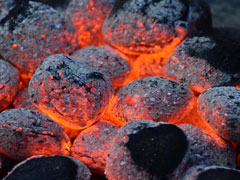




Back to the Intro Page







Farming had now changed a little as people had learned that it was a good idea to leave a field fallow for a year every so often. Leaving it fallow means that you didnít grow anything on it, you just left it for the cattle and sheep to graze on. This allows some of the goodness, taken out by the crops, to return. All crops take some goodness from the soil and if you keep growing the same thing on the same land the yield, the amount of barley, oats, whatever that you get becomes less. By the start of this period some craftsmen were making a living from just selling their goods. Women would weave the clothes and also brew the beer. Children used dogs to herd cattle and sheep. Men spent time cutting trees to clear land for ploughing and to sow crops. As trees were cut down, people would produce charcoal that was used in the making of iron. Charcoal is wood, burnt very slowly and not allowed to burn completely. Making it can take days. I wonder who discovered how to do it? In some parts of the country monks would produce salt. Early lathes were built to help carpenters. A lathe is a machine which holds a piece of wood while slowly turning it around. This allows the carpenter to create more rounded pieces such as bowls, furniture and wheels for carts and ploughs. Metalworkers made iron tools, knives and swords and potters would, funnily enough, make pots from clay while other craftsmen made jewellery from gold, gemstones and glass.
Back to the Angles and the Saxons Hoots - Daily LifeForward to Mainly the Vikings Hoots - Daily Life

